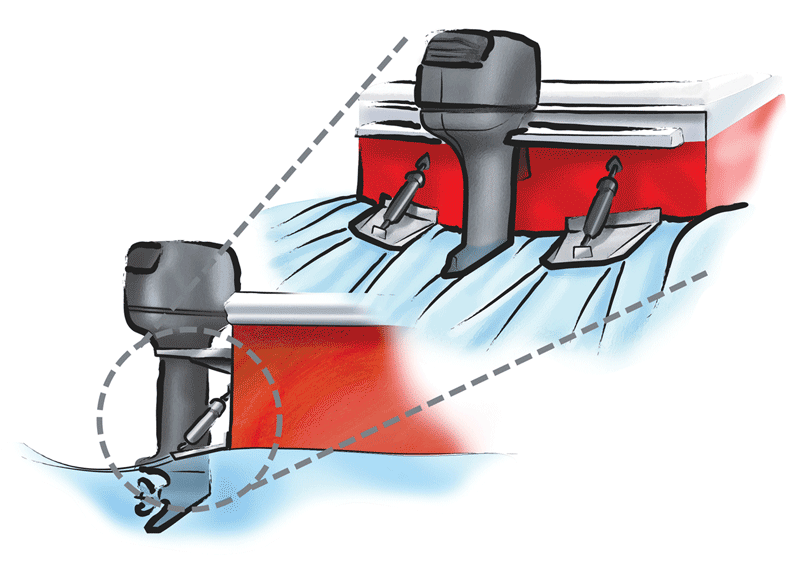As a young marine mechanic, I worked with an old salt who swore a good hull doesn’t need trim tabs. He was probably right about some hulls, but generally, adding trim tabs can make a good hull perform even better. Tabs give the skipper much more control as well as the ability to create dramatic changes to ride attitude.
By definition, trim tabs are flat appendages, typically fashioned from stainless steel or aluminum, which are attached to the bottom edge of a hull’s transom. By moving them up or down together or independently, using electro-mechanical or hydraulic activators controlled at the dashboard, the driver can adjust the hull’s ride attitude to compensate for changing water conditions or irregular load (more weight on one side than the other, or the bow or stern loaded too heavily). They function and operate much the same as ailerons on an airplane wing.
WHAT’S AVAILABLE?
There are fairly clear choices, very few different types and actuating systems, and installation is not at all difficult. Many hull manufacturers offer them as factory-installed options or even standard equipment; however, this is typically only the case on larger and/or more expensive models. It is rare when a boat under 24 feet is offered with trim tabs. Usually, this is only on specialty rigs such as flats or bass fishing boats.
Trim tabs come in many sizes to fit a wide range of hulls. Typically, most models are about a foot wide by a foot long. They’re fashioned from flat plates of stainless steel. High-performance models are typically cast aluminum. Most popular trim tabs are actuated remotely, but models that use water pressure balanced with mechanical pressure to move them are also popular due to their simplicity and lower cost.
WHAT’S INVOLVED?
Tabs are mounted on the transom parallel to the boat’s bottom, about 3/8 of an inch above the running surface. The actuators are bolted to the transom, and the hydraulic lines (or electrical wires) are run through holes in the transom. All holes are sealed with marine sealer. With hydraulic tabs, the electro-hydraulic pump motor is mounted inside the boat. The control unit is mounted at the dash within easy reach of the operator.
With “automatic” tabs, of course, there’s no pump motor, remote control unit or related wiring. The entire installation is done at the transom.
ADJUSTMENT AND PERFORMANCE
The driver can use the remote adjustment controls to raise or lower the tabs, together or independently. To correct a “list” (leaning to one side), one tab can be lowered while the other is raised. This feature is great when passengers want to sit together on one side of the boat. When the boat is overloaded to the stern, both tabs can be dropped, thereby leveling the fore-aft ride. Conversely, with a heavy load up front, the tabs can be raised to help lift the bow.
Adjusting ride attitude to cope with different water conditions is another key feature. In rough water, the tabs can be lowered to force the bow down so the hull rides flatter with more wetted surface. The increased surface contact smoothes out the ride, although at the expense of fuel economy (more wetted hull surface equals more drag). The tabs can be raised in calm water to help lift the bow and decrease wetted surface, boosting speed and increasing fuel mileage.
Trim tabs also help pulling skiers. Dropping the tabs down, the driver can lift the stern and lower the bow, causing quicker planing. Planing more quickly and in shorter distance also helps anglers fishing shallows.
LATEST DEVELOPMENTS
Auto adjusting, remote-controlled trim tabs are now available. A computer-controlled electronic unit continually adjusts the tabs based on constant sampling of the boat’s ride attitude and speed using GPS and gyroscopes. They combine the advantages of trim tabs without the guesswork and constant adjusting involved with operator controls. Auto-adjusting tabs that don’t require remote dash controls are also available, and these do a great job of controlling ride attitude for changing water conditions and loads without the complexity and time investment of remote-controlled tabs. These tabs can help correct a myriad of performance issues at very little cost. They use a gas-charged shock to apply downward pressure to the tab plate. At lower speeds, this helps the boat plane more quickly. At higher speeds, water pressure on the underside of the tab pushes the tab up, increasing boat speed. This is a great solution for those who need the performance advantages of adjustable tabs but don’t want the complexity and potential problems of remote-controlled units. As an example, this author knows personally of a high performance outboard hull that was undriveable until a set of self-actuating tabs was installed.
INVESTMENT
Expect to pay at least $500 for the most basic set of remote-actuated tabs for a smaller (16- to 20-foot) hull. Larger and high-performance versions range from $1,000 all the way to $12,000 and even higher for tabs built for yachts and high-end ocean performance hulls. However, self-actuating tabs such as Nauticus’ Smart Tabs sell for as little as $150, and installing them takes less than an hour even for weekend mechanics. Those who prefer to let their marina do the work, add at least a half-day’s labor or more (for installation of remote-actuated units) to the “tab.”
SOURCES
Insta-Trim™ Boat Leveler Co.
7305 Natural Bridge Rd.
Saint Louis, MO 63121
800.386.7470
www.insta-trim.com
Lenco Marine, Inc.
4700 SE Municipal Court
Stuart, FL 34997
772.288.2662
www.lencomarine.com
Nauticus, Inc.
8080 Snowville Road
Brecksville, OH 44141
800.233.0194
www.nauticusinc.com
[easy-social-share]
